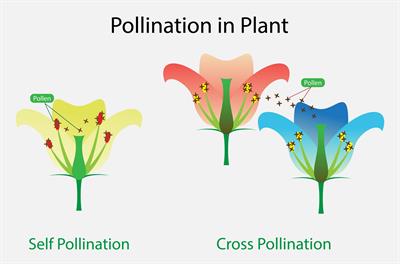
PUMPA - SMART LEARNING
எங்கள் ஆசிரியர்களுடன் 1-ஆன்-1 ஆலோசனை நேரத்தைப் பெறுங்கள். டாப்பர் ஆவதற்கு நாங்கள் பயிற்சி அளிப்போம்
Book Free DemoReproduction in plants starts with pollination.
The transfer of pollen grains from the anther to the stigma is called pollination.
Types of pollination
1. Self-pollination:
In self pollination, pollen grain from anther of the flower reaches the stigma of the same flower or the same plant. It occurs mostly in a bisexual flower.
- Self-pollinating flowers do not produce more pollens as the stigma is very near to it.
- The new plant produced may not show difference in characteristics.
2. Cross-pollination:
In cross pollination, pollen grains from the anther (of a flower or of a plant) reaches the stigma of a flower of a different plant of the same kind.
- Male flowers produced more pollens so that it reaches the female flower, which may not be in its vicinity.
- The new plant produced have characteristics of both the plants.

Agents of pollination
The agents of pollination such as wind, insects, butterflies and birds are called pollinators.
Fertilisation
The process by which male gamete fuses with the female gamete to form a zygote is called fertilisation.
When pollen grains are transferred or deposited on stigma (pistil), it starts germination. A long pollen tube develops from pollen grain which passes through the style to the ovary (female gametes). The male gametes move down the pollen tube, and the tube enters the ovule inside the ovary.
In the ovary, the male gametes fuse with female gametes to form a fertilised egg cell called zygote.
The zygote develops into an embryo which is a part of a seed that develops into a new plant.
